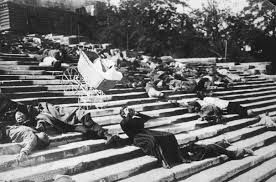- 3d to cinema montage series
- Steven Bannon(assistant to the president and chief strategist in the Donald trump administration and founder of Breitbart news):
Filmmaker and propaganda workers bout the war
Eisenstein
- Soviet montage.
This theory is an approach to understanding and creating cinema that relies heavily upon editing (montage is French for assembly or editing). This is principal contribution of soviet film theories to global cinema and brought formalism to bear on filmmaking/
2 things: images semiotic meaning; how they are put together.
- Formalism?
Formalism theory is a theory of film study that is focused on the formal, or technical elements of a film. (the lighting, scoring, use of color, sound, and design shot composition, and editing).
- Ppl development of montage:
Lev kuleshov(father of montage theory)
Serge Eisenstein (the representation of montage theory)
Vsevolod pudovkin (mise-en-scene)
Dziga vertov(kinoks)
- In 1917, Russian revolution. The first film school was controlled by the government due to the purpose of the tool to promote ideology and propaganda.
VGIK-the name of the film school.
Purpose: agitation + propaganda
Then the kuleshov workshop came out due to the fact kule thinks the school doesn’t fit hes purpose
- https://www.youtube.com/watch?v=JYedfenQ_Mw (the history of cutting- the soviet theory of montage)
notes: 1, Russian revolution-Lev Kuleshov workshop-the Kuleshow effect(soup+ beautiful women+a male’s facial expressions. He played with the sequences of the same shots and creating different vibes)
2, D.W.Griffin: developed continuity editing through practice; film as enhanced theater within real space and time
3,Sergei Eisenstein: developed montage through theory; breaking confines of space and time to make film a unique language,(battaleship potemkin )
)
INTOLERANCE this movie became super impact on Russian’s film history, it wasn’t quite popular at the moment. And it was a reference for study in VGIK School for ten years, which all the students become the propaganda maker in the future Russia. Kule workshop was analysis the film at that time as well.
Kuleshov is the first one whos practise editing and switch forwards and backwards the sequence of the shot to create a montage, tht lead auditions to feel different feelings. And he is the first one who actually used this method in film making. (About the gone and emotion changes, if we switch the sequence, audition will receive a totally different ideas nd feeling. Tht how movie can be used to manipulating human emotions and even actions)
- BATTLESHIP POTEMKIN (go watch the birth of montage)
EXTREME SUCCSSEFUL PROPOGANDA FILM—the Odessas steps
- EISENSTEIN: 5 METHODS OF MONTAGE
1, METRIC (Where the editing follows a specific number of frames, this is based purely on the physical nature of time, cutting to the next shot no matter what is happening within the image. The reason for this is to get an emotional reaction from the audience.)
2, RHYTHMIC (The cutting happens for the sake of continuity. This creates visual continuity but it may also be used in order to keep with the pace of the film. A good example of this is the the legendary car/train chase scene in The French Connection.)
3, Tonal (concerning with tone of shot, lighting and cutting, the shading, the angles of the shot) ( A tonal montage uses the emotional meaning of the shots. Not just manipulating the temporal length of the cuts or its rhythmical characteristics. The point of this is to elicit a reaction that is more complex than Rhythmic and Metric. An example of this is in one of Eisenstein’s films called Battleship Potemkin where the character ‘Vakulinchuk’ dies.)
4, Over tonal (An accumulation of metric, rhythmic, and tonal montage to synthesise its effect on the audience for an even more abstract and complicated effect.)
5, Intellectual or ideologicalLidead, obstrac. synbolism.)(Uses a combination of shots from outside the film in order to create a meaning. A good example of this would be the scene from apocalypse now where Klutz is being executed. They mix in shots of a water buffalo being slaughtered.)
Sometimes, too much editing can ruin the sense of the film, makes audition confused and lost the narrative structure. SO DON’T OVER DO THE CUTTING.
Leads to
- OCTOBER/ psycho
- Continuity editing vs montage editing (2 biggest cinematic techniques)
- Fictionalize geography
- Roger William corman: the pope of pop film